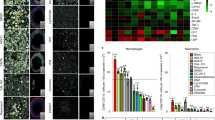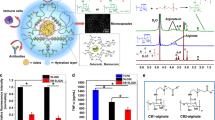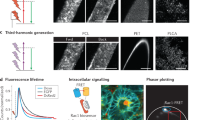Abstract
The efficacy of implanted biomedical devices is often compromised by host recognition and subsequent foreign body responses. Here, we demonstrate the role of the geometry of implanted materials on their biocompatibility in vivo. In rodent and non-human primate animal models, implanted spheres 1.5 mm and above in diameter across a broad spectrum of materials, including hydrogels, ceramics, metals and plastics, significantly abrogated foreign body reactions and fibrosis when compared with smaller spheres. We also show that for encapsulated rat pancreatic islet cells transplanted into streptozotocin-treated diabetic C57BL/6 mice, islets prepared in 1.5-mm alginate capsules were able to restore blood-glucose control for up to 180 days, a period more than five times longer than for transplanted grafts encapsulated within conventionally sized 0.5-mm alginate capsules. Our findings suggest that the in vivo biocompatibility of biomedical devices can be significantly improved simply by tuning their spherical dimensions.
This is a preview of subscription content, access via your institution
Access options
Subscribe to this journal
Receive 12 print issues and online access
$259.00 per year
only $21.58 per issue
Buy this article
- Purchase on Springer Link
- Instant access to full article PDF
Prices may be subject to local taxes which are calculated during checkout





Similar content being viewed by others
References
Kearney, C. J. & Mooney, D. J. Macroscale delivery systems for molecular and cellular payloads. Nature Mater. 12, 1004–1017 (2013).
Farra, R. et al. First-in-human testing of a wirelessly controlled drug delivery microchip. Sci. Transl. Med. 4, 122ra121 (2012).
Nichols, S. P., Koh, A., Storm, W. L., Shin, J. H. & Schoenfisch, M. H. Biocompatible materials for continuous glucose monitoring devices. Chem. Rev. 113, 2528–2549 (2013).
Rosen, M. R., Robinson, R. B., Brink, P. R. & Cohen, I. S. The road to biological pacing. Nature Rev. Cardiol. 8, 656–666 (2011).
Hubbell, J. A. & Langer, R. Translating materials design to the clinic. Nature Mater. 12, 963–966 (2013).
Franz, S., Rammelt, S., Scharnweber, D. & Simon, J. C. Immune responses to implants—a review of the implications for the design of immunomodulatory biomaterials. Biomaterials 32, 6692–6709 (2011).
Anderson, J. M., Rodriguez, A. & Chang, D. T. Foreign body reaction to biomaterials. Semin. Immunol. 20, 86–100 (2008).
Williams, D. F. On the mechanisms of biocompatibility. Biomaterials 29, 2941–2953 (2008).
Ratner, B. D. Reducing capsular thickness and enhancing angiogenesis around implant drug release systems. J. Control. Release 78, 211–218 (2002).
Bryers, J. D., Giachelli, C. M. & Ratner, B. D. Engineering biomaterials to integrate and heal: The biocompatibility paradigm shifts. Biotechnol. Bioeng. 109, 1898–1911 (2012).
Zhang, L. et al. Zwitterionic hydrogels implanted in mice resist the foreign-body reaction. Nature Biotechnol. 31, 553–556 (2013).
Smith, R. S. et al. Vascular catheters with a nonleaching poly-sulfobetaine surface modification reduce thrombus formation and microbial attachment. Sci. Transl. Med. 4, 153ra132 (2012).
Ma, M. et al. Development of cationic polymer coatings to regulate foreign-body responses. Adv. Mater. 23, H189–H194 (2011).
Rodriguez, P. L. et al. Minimal “Self” peptides that inhibit phagocytic clearance and enhance delivery of nanoparticles. Science 339, 971–975 (2013).
Kim, Y. K., Que, R., Wang, S. W. & Liu, W. F. Modification of biomaterials with a self-protein inhibits the macrophage response. Adv. Healthc. Mater. 3, 989–994 (2014).
Madden, L. R. et al. Proangiogenic scaffolds as functional templates for cardiac tissue engineering. Proc. Natl Acad. Sci. USA 107, 15211–15216 (2010).
Kusaka, T. et al. Effect of silica particle size on macrophage inflammatory responses. PLoS ONE 9, e92634 (2014).
Zandstra, J. et al. Microsphere size influences the foreign body reaction. Eur. Cells Mater. 28, 335–347 (2014).
Matlaga, B. F., Yasenchak, L. P. & Salthouse, T. N. Tissue response to implanted polymers: The significance of sample shape. J. Biomed. Mater. Res. 10, 391–397 (1976).
Salthouse, T. N. Some aspects of macrophage behavior at the implant interface. J. Biomed. Mater. Res. 18, 395–401 (1984).
Helton, K. L., Ratner, B. D. & Wisniewski, N. A. Biomechanics of the sensor-tissue interface-effects of motion, pressure, and design on sensor performance and the foreign body response-part I: Theoretical framework. J. Diabetes Sci. Technol. 5, 632–646 (2011).
Brauker, J. H. et al. Neovascularization of synthetic membranes directed by membrane microarchitecture. J. Biomed. Mater. Res. 29, 1517–1524 (1995).
Ward, W. K., Slobodzian, E. P., Tiekotter, K. L. & Wood, M. D. The effect of microgeometry, implant thickness and polyurethane chemistry on the foreign body response to subcutaneous implants. Biomaterials 23, 4185–4192 (2002).
Lee, K. Y. & Mooney, D. J. Alginate: Properties and biomedical applications. Prog. Polym. Sci. 37, 106–126 (2012).
Whelehan, M. & Marison, I. W. Microencapsulation using vibrating technology. J. Microencapsulation 28, 669–688 (2011).
Lim, F. & Sun, A. M. Microencapsulated islets as bioartificial endocrine pancreas. Science 210, 908–910 (1980).
Scharp, D. W. & Marchetti, P. Encapsulated islets for diabetes therapy: History, current progress, and critical issues requiring solution. Adv. Drug Deliv. Rev. 67–68, 35–73 (2014).
Dolgin, E. Encapsulate this. Nature Med. 20, 9–11 (2014).
Dang, T. T. et al. Spatiotemporal effects of a controlled-release anti-inflammatory drug on the cellular dynamics of host response. Biomaterials 32, 4464–4470 (2011).
King, A., Sandler, S. & Andersson, A. The effect of host factors and capsule composition on the cellular overgrowth on implanted alginate capsules. J. Biomed. Mater. Res. 57, 374–383 (2001).
Kolb, M. et al. Differences in the fibrogenic response after transfer of active transforming growth factor-β1 gene to lungs of “fibrosis-prone” and “fibrosis-resistant” mouse strains. Am. J. Respir. Cell Mol. Biol. 27, 141–150 (2002).
Lekka, M., Sainz-Serp, D., Kulik, A. J. & Wandrey, C. Hydrogel microspheres: Influence of chemical composition on surface morphology, local elastic properties, and bulk mechanical characteristics. Langmuir 20, 9968–9977 (2004).
Shellenberger, K. & Logan, B. E. Effect of molecular scale roughness of glass beads on colloidal and bacterial deposition. Environ. Sci. Technol. 36, 184–189 (2002).
Papajova, E., Bujdos, M., Chorvat, D., Stach, M. & Lacik, I. Method for preparation of planar alginate hydrogels by external gelling using an aerosol of gelling solution. Carbohydr. Polym. 90, 472–482 (2012).
Fujie, T. et al. Evaluation of substrata effect on cell adhesion properties using freestanding poly(L-lactic acid) nanosheets. Langmuir 27, 13173–13182 (2011).
Qi, M. et al. A recommended laparoscopic procedure for implantation of microcapsules in the peritoneal cavity of non-human primates. J. Surg. Res. 168, e117–e123 (2011).
Dang, T. T. et al. Enhanced function of immuno-isolated islets in diabetes therapy by co-encapsulation with an anti-inflammatory drug. Biomaterials 34, 5792–5801 (2013).
de Groot, M., Schuurs, T. A. & van Schilfgaarde, R. Causes of limited survival of microencapsulated pancreatic islet grafts. J. Surg. Res. 121, 141–150 (2004).
Strand, B. L., Gaserod, O., Kulseng, B., Espevik, T. & Skjak-Baek, G. Alginate-polylysine-alginate microcapsules: Effect of size reduction on capsule properties. J. Microencapsulation 19, 615–630 (2002).
Robitaille, R. et al. Studies on small (<350 microm) alginate-poly-L-lysine microcapsules. III. Biocompatibility Of smaller versus standard microcapsules. J. Biomed. Mater. Res. 44, 116–120 (1999).
Shi, C. & Pamer, E. G. Monocyte recruitment during infection and inflammation. Nature Rev. Immunol. 11, 762–774 (2011).
Burnett, S. H. et al. Conditional macrophage ablation in transgenic mice expressing a Fas-based suicide gene. J. Leukocyte Biol. 75, 612–623 (2004).
Gordon, S. Alternative activation of macrophages. Nature Rev. Immunol. 3, 23–35 (2003).
Mosser, D. M. & Edwards, J. P. Exploring the full spectrum of macrophage activation. Nature Rev. Immunol. 8, 958–969 (2008).
Murray, P. J. et al. Macrophage activation and polarization: Nomenclature and experimental guidelines. Immunity 41, 14–20 (2014).
Gordon, S. & Martinez, F. O. Alternative activation of macrophages: Mechanism and functions. Immunity 32, 593–604 (2010).
Lacy, P. E. & Kostianovsky, M. Method for the isolation of intact islets of Langerhans from the rat pancreas. Diabetes 16, 35–39 (1967).
Morch, Y. A., Donati, I., Strand, B. L. & Skjak-Braek, G. Effect of Ca2+, Ba2+, and Sr2+ on alginate microbeads. Biomacromolecules 7, 1471–1480 (2006).
Ricordi, C. et al. Islet isolation assessment in man and large animals. Acta Diabetol. Lat. 27, 185–195 (1990).
Adewola, A. F. et al. Microfluidic perifusion and imaging device for multi-parametric islet function assessment. Biomed. Microdevices 12, 409–417 (2010).
Keizer, J. & Magnus, G. ATP-sensitive potassium channel and bursting in the pancreatic beta cell. A theoretical study. Biophys. J. 56, 229–242 (1989).
Acknowledgements
This work was supported by the Juvenile Diabetes Research Foundation (JDRF) (Grant 17-2007-1063), the Leona M. and Harry B. Helmsley Charitable Trust Foundation (Grant 09PG-T1D027), the National Institutes of Health (Grants EB000244, EB000351, DE013023 and CA151884), the Koch Institute Support (core) Grant P30-CA14051 from the National Cancer Institute, and also by a generous gift from the Tayebati Family Foundation. O.V. was supported by JDRF and DOD/CDMRP postdoctoral fellowships (Grants 3-2013-178 and W81XWH-13-1-0215, respectively). J.O. is supported by the National Institutes of Health (NIH/NIDDK) R01DK091526 and the Chicago Diabetes Project. J.M-E. is supported by the American Diabetes Association (ADA) Clinical Scientist Training Award (7-12-CST-03) and the American Society of Transplant Surgeons (ASTS) Presidential Student Mentor Award. The authors would like to acknowledge the use of resources at the Koch Institute Swanson Biotechnology Center for technical support, specifically, the Hope Babette Tang Histology, Microscopy, Flow Cytometry, and Animal Imaging and pre-clinical testing core facilities. We acknowledge the use of imaging resources at the W. M. Keck Biological Imaging Facility (Whitehead Institute) and assistance from W. Salmon. We thank R. Bogorad and K. Whitehead for helpful discussions and feedback on the manuscript.
Author information
Authors and Affiliations
Contributions
O.V., J.C.D., M.M. and D.G.A. conceived the idea, designed experiments, analysed data, and wrote the manuscript. O.V., J.C.D., M.M. A.J.V., A.R.B., J.L., E.L., J.W., W.S.L., S.J., A.C., S.S., K.T., J.H-L., S.A-D., M.B., J.M-E., Y.W., M.Q., D.M.L., M.C., N.D., R.T., I.L., G.C.W. and J.O. performed experiments. H.H.T. performed statistical analyses of data sets and aided in the preparation of displays communicating data sets. G.C.W., J.O. and D.L.G. provided conceptual advice and technical support. R.L. and D.G.A. supervised the study. All authors discussed the results and assisted in the preparation of the manuscript.
Corresponding author
Ethics declarations
Competing interests
The authors declare no competing financial interests.
Supplementary information
Supplementary Information
Supplementary Information (PDF 3904 kb)
Supplementary Movie 1
Supplementary Movie 1 (AVI 9772 kb)
Supplementary Movie 2
Supplementary Movie 2 (AVI 9703 kb)
Supplementary Movie 3
Supplementary Movie 3 (AVI 5065 kb)
Supplementary Movie 4
Supplementary Movie 4 (AVI 5065 kb)
Supplementary Movie 5
Supplementary Movie 5 (AVI 5065 kb)
Supplementary Movie 6
Supplementary Movie 6 (AVI 6752 kb)
Supplementary Movie 7
Supplementary Movie 7 (AVI 5065 kb)
Supplementary Movie 8
Supplementary Movie 8 (AVI 5065 kb)
Rights and permissions
About this article
Cite this article
Veiseh, O., Doloff, J., Ma, M. et al. Size- and shape-dependent foreign body immune response to materials implanted in rodents and non-human primates. Nature Mater 14, 643–651 (2015). https://doi.org/10.1038/nmat4290
Received:
Accepted:
Published:
Issue Date:
DOI: https://doi.org/10.1038/nmat4290
This article is cited by
-
Janus microparticles-based targeted and spatially-controlled piezoelectric neural stimulation via low-intensity focused ultrasound
Nature Communications (2024)
-
IRAK4 inhibition: an effective strategy for immunomodulating peri-implant osseointegration via reciprocally-shifted polarization in the monocyte-macrophage lineage cells
BMC Oral Health (2023)
-
Immunization against Zika by entrapping live virus in a subcutaneous self-adjuvanting hydrogel
Nature Biomedical Engineering (2023)
-
Screening hydrogels for antifibrotic properties by implanting cellularly barcoded alginates in mice and a non-human primate
Nature Biomedical Engineering (2023)
-
Low-cost and prototype-friendly method for biocompatible encapsulation of implantable electronics with epoxy overmolding, hermetic feedthroughs and P3HT coating
Scientific Reports (2023)



